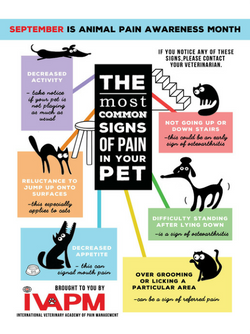
September is Animal Pain Awareness Month, created by the International Veterinary Academy of Pain Management, to encourage various individuals and organizations such as clinics, veterinarians, veterinary technicians, veterinary educators and the veterinary industry as a whole to raise awareness about pain and pain management in veterinary patients.
As with humans, pain management is an important part of medical treatment and care to promote healing and wellness. Although we all be different species, humans and animals both feel and process pain in a similar fashion. If pain is not managed, it can lead to further health issues and impede healing and recovery.
Animals are predisposed to hide pain, and are usually masters at it. They certainly can’t tell us what’s hurting them, as much as that would help us. Often, our pets will only show signs of pain once it has become extreme. As an engaged and informed pet owner, it is good to be able to recognize the signs of pain in your pets. This allows you to visit the vet promptly and have them diagnose any conditions early, which can improve the outcome of any treatment that mat be required. Pain management is also crucial throughout the treatment process, to keep your pet comfortable and encourage healing and recovery, regardless of the condition or procedure.
Some signs that you can look for to indicate your pet may be in pain are below:
| DOGS | CATS |
|
|
If you notice any of the above signs, are concerned that your pet may be in pain, or may have a condition that is causing them pain, visit your veterinarian. They will be able to run tests and perform diagnostics to find out what is bothering your pet and develop an appropriate treatment plan. Often, as pet owners, it is difficult to see a gradual change in our pet’s behavior, so be diligent in taking note of even small changes. There are no silly reasons to visit the vet if you are concerned, and at the very least, a ‘wellness check’ will bring you peace of mind, if nothing turns out to be wrong. Catching illness and disease early is important to being able to provide your pet with effective treatment before the condition gets too far along.
If your pet has been diagnosed with pain, especially as secondary to another disease or condition, it can be difficult to know or gauge how much pain the may be in on a regular basis. Remote monitors, usually worn as collars, can track your pet’s vital signs to show trends that indicate how their pain levels are being managed, among other things. Ask your veterinarian if remote monitoring your pet may be an effective part of their treatment plan.
As with humans, recognizing pain as a symptom of something larger going on in the body can be important for early diagnosis and treatment. As our animal friends are unable to tell us when they are in pain, it is up to us to know the signs to look for, and act appropriately to get them the treatment and care they deserve.